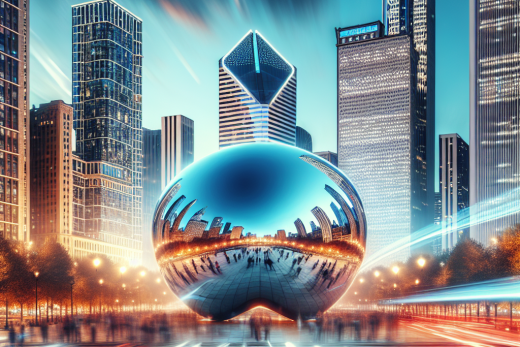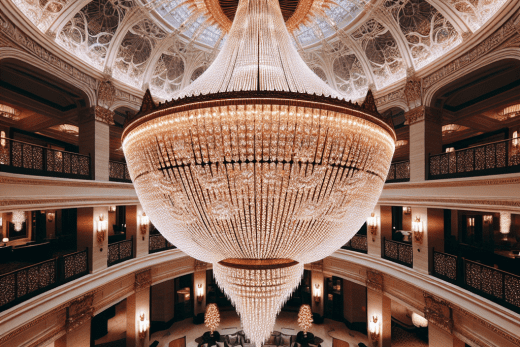Step back in time and immerse yourself in the captivating stories of one of Chicago’s most iconic hotels. “A Glimpse Into History: The Lexington Hotel Chicago Stories” offers a fascinating journey through the past, as you discover the secrets and tales that have shaped this legendary establishment. From famous guests to notorious gangsters, the Lexington Hotel’s history is filled with intrigue and allure. Join us as we venture into the past and uncover the untold stories that have made this hotel an integral part of Chicago’s rich heritage.

Prohibition Era and Al Capone’s Influence
The Rise of Prohibition
The Prohibition Era, also known as the Noble Experiment, was a period in American history from 1920 to 1933 when the production, sale, and distribution of alcoholic beverages were banned. This radical measure was intended to reduce crime, corruption, and the social ills associated with alcohol consumption. However, instead of achieving its intended goals, Prohibition led to the rise of organized crime and underworld activities, with gangsters like Al Capone becoming household names.
Al Capone’s Presence in Chicago
Among the various notorious figures that emerged during the Prohibition Era, Al Capone became a legendary figure. Capone, also known as Scarface, reigned as the kingpin of organized crime in Chicago, establishing a vast empire fueled by bootlegging, gambling, and other illicit activities. With his calculated business strategies and ruthless enforcement methods, Capone became known as one of the most powerful and feared individuals in the city’s history.
The Lexington Hotel as Al Capone’s Headquarters
Central to Al Capone’s influence and operations in Chicago was the iconic Lexington Hotel, located at the bustling intersection of Michigan Avenue and 22nd Street. This luxurious hotel provided Capone with the perfect cover to conduct his illegal activities discreetly. The hotel not only served as Capone’s base of operations but also became a symbol of his power and extravagant lifestyle. The significance of the Lexington Hotel in the history of the Prohibition Era cannot be overstated.
Construction and Architecture
Design and Architecture of The Lexington Hotel
Constructed in 1892, The Lexington Hotel was designed by architect Clinton J. Warren in the Beaux-Arts architectural style. This style, characterized by its grandeur and classical elements, perfectly suited the ambitious vision of the hotel. The exteriors displayed intricate ornamentation, while the interiors boasted lavish features such as marble floors, towering columns, and ornate moldings. The careful attention to detail in the design and architecture of the Lexington Hotel contributed to its timeless beauty and captivating allure.
Notable Features and Amenities
The Lexington Hotel boasted an array of notable features and amenities that catered to the luxury needs of its wealthy clientele. From the moment guests entered the grand lobby, they were greeted by a stunning chandelier and opulent furnishings. The hotel’s dining options were equally lavish, with the Palm Room serving exquisite cuisine and offering live music entertainment. The Lexington Hotel’s opulent ballroom, fitness center, and rooftop garden were other highlights that made it a sought-after destination for high-profile guests.
Renovations and Restorations Throughout the Years
Over the years, The Lexington Hotel underwent several renovations and restorations to maintain its grandeur and relevance. One significant restoration effort took place in the 1980s, led by architect John Vinci, who painstakingly preserved the hotel’s historical character while updating its facilities to meet modern standards. This commitment to restoration ensured that the Lexington Hotel continued to captivate visitors and retain its status as a landmark of Chicago’s architectural heritage.
Famous Guests and Noteworthy Events
Celebrities and Influential Figures Who Stayed at The Lexington Hotel
The Lexington Hotel played host to a multitude of celebrities and influential figures throughout its illustrious history. From Hollywood stars to politicians and renowned artists, the hotel’s guest list read like a who’s who of the 20th century. Clark Gable, Frank Sinatra, and Judy Garland were just a few of the celebrities who sought refuge within the Lexington’s elegant walls. Not only did the hotel attract A-listers, but it also became a meeting place for politicians and businessmen, making it a hub of activity and intrigue.
Noteworthy Events and Gatherings
Beyond its famous guests, The Lexington Hotel was the site of various noteworthy events and gatherings. The hotel’s ballroom was a popular venue for extravagant parties, charitable events, and corporate galas. Additionally, the hotel hosted high-stakes poker games and served as a meeting place for important discussions among Capone and his associates. The Lexington Hotel’s reputation as a hub of social activity and an epicenter of power continued to grow with each passing event.
The Legend of Marilyn Monroe and Room 808
One of the hotel’s most enduring legends is the connection to cultural icon Marilyn Monroe. Rumor has it that Monroe once resided in Room 808 of the Lexington Hotel. This myth, while intriguing, lacks historical evidence, but it has captured the imaginations of countless visitors and paranormal enthusiasts. Regardless of the veracity of the tale, the allure of the Lexington Hotel and its association with Marilyn Monroe only adds to its mystique and popularity.
Decline and Closure
Changing Times and Economic Challenges
As the Prohibition Era came to an end, the demand for illicit activities dwindled, posing a significant challenge for Al Capone and his criminal empire. Additionally, the country was gripped by the Great Depression, a time of economic hardship that affected even the most extravagant establishments. The changing times and economic challenges presented a threat to the continued operation of the Lexington Hotel.
Decline of The Lexington Hotel
With the decline of the Prohibition era and the subsequent economic hardships, the Lexington Hotel’s reputation and profitability suffered. The lavish lifestyle that had characterized its glory days became less sustainable, and the once-lively corridors and buzzing restaurants began to lose their vibrancy. As the years passed, the grandeur of the Lexington Hotel faded, and an air of decline settled upon its halls.
Closure and Legacy
Sadly, in 1995, the Lexington Hotel closed its doors, marking the end of an era. The hotel that had epitomized luxury and opulence during its heyday was now left empty and abandoned. However, despite its closure, the legacy of the Lexington Hotel and its connection to Al Capone and the Prohibition Era continued to capture the imagination of people from all walks of life.

Haunted Legends and Supernatural Stories
Ghost Stories and Haunted History
With a history as rich and tumultuous as the Lexington Hotel’s, it comes as no surprise that it has earned a reputation for being haunted. Numerous stories of ghostly encounters, unexplained phenomena, and eerie sightings have become intertwined with the property’s lore. Ghostly figures wandering the halls, phantom voices heard in empty rooms, and cold spots have all been reported by guests and paranormal enthusiasts, solidifying the hotel’s haunted reputation.
Paranormal Investigations and Reports
Over the years, paranormal investigators and enthusiasts have flocked to the Lexington Hotel, seeking answers to the inexplicable occurrences reported on the premises. Equipped with advanced equipment and a determination to uncover the truth, these investigators have documented numerous instances of paranormal activity. From EVP (electronic voice phenomena) recordings to unexplained temperature fluctuations, the evidence collected only deepens the mystique surrounding the hotel.
Popular Culture and The Lexington’s Haunted Reputation
The haunting legends of the Lexington Hotel have made their mark on popular culture, with references and homages appearing in various mediums. From movies and TV shows to books and documentaries, the supernatural stories surrounding the hotel continue to captivate audiences and fuel the imagination. These artistic representations help keep the legacy of the Lexington Hotel alive, even decades after its closure.
Artistic Representation and Pop Culture
The Lexington Hotel in Movies and TV Shows
The Lexington Hotel’s intriguing history and haunted reputation have made it a compelling setting for movies and TV shows. Its luxurious interiors, filled with intrigue and hidden secrets, have been brought to life on the big and small screens. From period dramas centered around the Prohibition Era to modern-day ghost stories, the Lexington Hotel has served as a captivating backdrop for countless thrilling narratives.
Musical References and Homages
The cultural impact of the Lexington Hotel extends beyond the visual medium. Musicians and songwriters have also drawn inspiration from its history and legends. References to the hotel, Al Capone, and the Prohibition Era are commonplace in various genres of music. Whether it be jazz bands playing in the extravagant ballroom or lyrics that pay homage to the hotel’s infamous past, the Lexington Hotel’s influence in music is undeniable.
Impact on Art and Literature
The artistic community has long found inspiration in the Lexington Hotel and its historical significance. Painters, sculptors, and writers have all sought to capture the essence of the hotel and the stories that surround it. Through their works, they have celebrated the hotel’s iconic architecture, delved into the tales of its famous guests, and even explored the supernatural mysteries that shroud the property.

Preservation and Restoration Efforts
Preservation Initiatives and Historical Significance
Recognizing the historical significance of the Lexington Hotel, preservation initiatives have been undertaken to ensure its legacy endures. The hotel’s impressive architecture and association with the Prohibition Era make it a valuable piece of Chicago’s history. Efforts to preserve the building not only honor its storied past but also serve as a reminder of the city’s cultural heritage and the transformative period of the Prohibition Era.
Restoration Projects and Plans
Restoration projects have been implemented to revitalize the Lexington Hotel and return it to its former glory. These projects aim to preserve its architectural integrity while adapting the building to meet contemporary needs. The goal is to strike a balance between honoring the past and embracing the future, providing a new lease of life for the landmark that has captivated so many.
Preserving The Lexington’s Legacy
Preserving the Lexington Hotel’s legacy extends beyond physical restoration and architectural preservation. Efforts are undertaken to curate collections of historical artifacts and memorabilia that showcase the hotel’s glamorous past. These exhibits allow visitors to step back in time and experience the grandeur of the Lexington Hotel, ensuring that its unique history remains alive and accessible for generations to come.
The Lexington Hotel Today
Current Status and Ownership
Today, the Lexington Hotel stands as a testament to the bygone era of opulence and intrigue. While it no longer operates as a hotel, the building has been repurposed to fulfill different roles within the community. It has been transformed into apartments, office spaces, and retail establishments, ensuring that its majestic presence remains a vibrant part of the city.
The Hotel’s Role in the Community
Beyond its physical transformation, the Lexington Hotel continues to play a role in the community. Its historical significance and connection to Al Capone and the Prohibition Era make it an attraction for history buffs, architecture enthusiasts, and curious visitors alike. The Lexington Hotel’s storied past serves as a reminder of Chicago’s tumultuous history and its ability to adapt and evolve over time.
Historical Tours and Visitors’ Experiences
Visitors today have the opportunity to explore the Lexington Hotel’s fascinating history through historical tours and immersive experiences. These tours provide insights into the Prohibition Era, the hauntings associated with the hotel, and the transformative changes that the building has undergone. Whether it be stepping into the grand ballroom or venturing into the rumored haunted corridors, visitors are transported back in time, leaving with a deeper appreciation for the legacy of the Lexington Hotel.
Personal Stories and Anecdotes
Staff and Local Community Insights
The staff and local community surrounding the Lexington Hotel have their own insights and perspectives on the property’s captivating history. Stories of employees encountering unexplained phenomena, rumors passed down through generations, and memorable interactions with guests provide a unique and personal lens through which to view the hotel’s legacy. These individual accounts add depth and richness to the tapestry of the Lexington Hotel’s story.
Guest Memories and Testimonials
Former guests of the Lexington Hotel have their own memories and testimonials that speak to the enchantment and allure of their experience. From stories of extravagant parties to encounters with famous figures, these firsthand accounts give a glimpse into the magic that once permeated the hotel’s halls. These personal recollections cement the Lexington Hotel’s place in their hearts and serve as a testament to its lasting impact on those who had the privilege of staying within its elegant walls.
Personal Connections to The Lexington Hotel
For some individuals, the connection to the Lexington Hotel runs even deeper. It may be a place where they worked, a gathering place for family celebrations, or even a source of inspiration for their artistic endeavors. These personal connections demonstrate the far-reaching influence of the Lexington Hotel and how it continues to shape the lives of those who have crossed paths with it.
Exploring The Lexington Hotel
Virtual Tour of the Hotel
For those unable to visit the Lexington Hotel in person, a virtual tour offers an immersive experience from the comfort of home. By utilizing modern technology and historical documentation, visitors can explore the hotel’s architectural highlights, step inside its beautifully appointed rooms, and learn about its fascinating history. This virtual journey allows everyone to become an armchair traveler and appreciate the beauty and intrigue of this iconic landmark.
Amenities and Services
While no longer a functioning hotel, the Lexington Hotel still offers various amenities and services through its new incarnations. From trendy restaurants and boutiques to contemporary accommodations and entertainment venues, the property now serves the needs of modern residents and visitors. These amenities seamlessly blend with the hotel’s historical features, creating a unique space that pays tribute to its past while embracing the present.
Historical Artifacts and Memorabilia
Throughout the Lexington Hotel, historical artifacts and memorabilia provide glimpses into its glamorous past. From photographs and newspaper clippings to preserved furniture and decor, these remnants of a bygone era allow visitors to connect with the captivating stories of the hotel. Whether it be admiring vintage advertisements or imagining the allure of a roaring party in the grand ballroom, these artifacts bring history to life within the walls of the Lexington Hotel.



